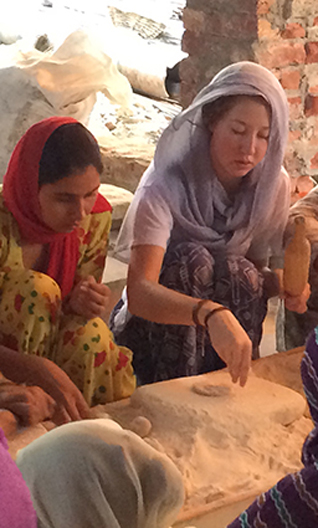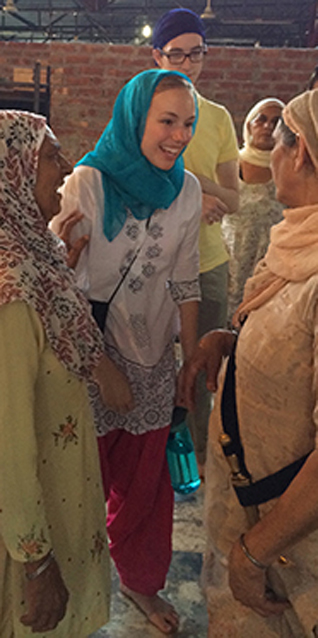
Above - Sarah Marshall. Below - Jessica Eller. Both, in the Langar at the Darbar Sahib (Golden Temple), Amritsar. Photos: Teresa Singh.

Travel
Langar At The Diag
MANDIRA BANERJEE
Ann Arbor, Michigan, USA
They spent part of their summer learning how to pull off a logistical miracle, feeding 60,000 people every day with a staff of volunteers at the Golden Temple in Amritsar -- one of the world’s biggest, busiest and most revered shrines.
Now, the University of Michigan students are back in Ann Arbor, and they want to share what they learned in Punjab by cooking a massive meal and giving away the food on Friday, September 19 on U-M’s campus.
They’re calling it “Langar at the Diag.”
“Langar” refers to the meal served at the end of public worship in a Gadara - a Sikh place of worship. It’s a centuries-old tradition in the Sikh religion that emphasizes social and economic equality as people share simple food together.
“American society needs spaces where rich and poor, people of all races and beliefs can come to share a common space.
This university langar can provide that medium,” said Jasprit Singh, a professor of electrical engineering and computer science who led the students’ summer trip to Punjab and the subcontinent.
The group will be cooking chickpeas, chutney and salad in shifts with help from the community at the Gurdwara in Plymouth, Michigan. The food will be packaged by hand into a tortilla wrap and served on the Diag all day on September 19. The group hopes to serve about 10,000 wraps. Any leftovers will be donated to a shelter.
While at the Golden Temple in June, the 13 U-M undergraduate students got up early every morning to do “seva,” or volunteer service. They chopped and cooked vegetables, washed lentils, made bread, cleaned dishes and learned how sustainable nourishment at the Golden Temple has worked for several centuries.
Their experience attracted media attention on the subcontinent as well.
The trip was part of the Global Intercultural Experience for Undergraduates program at U-M. Michael Jordan, director of Center for Global and Intercultural Study (CGIS), said that the Golden Temple program is a model of what GIEU does.
“By contributing their own time and having learned from their experience, the group is now bringing that tradition back to U-M,” he said.
Jessica Eller, a junior at the Ford School of Public Policy, was part of the group.
“This trip was about humility and inspiration,” she said, adding that it has widened her perspective about who’s a volunteer and who is a recipient.
“The person sitting next to me during the meal could be a millionaire from London one day and a beggar girl the next day. Everyone received the same service,” she said.
Along with handing out vegetarian chickpea wraps, the students will be on the Diag ready to talk about their experiences at the gurdwara.
Sarah Marshall, a junior studying environment and international studies, said she will discuss the love and compassion she received in Amritsar. She chose to make rotis (Punjabi bread) as her seva and soon formed a community with the women there.
“I didn’t speak the language, but I could see their eyes light up every morning when I came,” she said. “It was a comfort to see familiar faces every morning.”
Radha Patel, a sophomore in the College of Literature, Science, and the Arts, said the experience really opened her eyes to what can be achieved by volunteer work.
“Community is very important in [Punjabi] culture,” she said.
Jasprit Singh, the engineering professor, grew up in Punjab and has been visiting the Golden Temple since he was a child. But he said he could not grasp the dedication of the volunteers who come together everyday to cook and serve a meal at the gurdwara.
“The students were surprised and moved by the enormity of the work done and the stress-free way how it gets done,” he said.
Along with hosting this event at the Diag, Jasprit Singh has developed a best-practices handbook that he wants to share with the local communities in Detroit, Ypsilanti and Ann Arbor. He also has received interest from several places, including Amsterdam, to host Langar and talk about volunteer work to bring a community together.
“There is a pleasure in creating an event that breaks the barriers we often find around us,” Jasprit Singh said.
[Courtesy: Global Michigan. Edited for sikhchic.com]
September 18, 2014
Conversation about this article
1: Baldev Singh (Bradford, United Kingdom), September 18, 2014, 12:24 PM.
Absolutely fantastic! This is Sikhism at its awesome best ,,, while the rest of the world and its ideologies are discriminating, hating and beheading!
2: Manbir Banwait (Fort McMurray, Alberta, Canada), September 18, 2014, 6:44 PM.
Couldn't have said it better myself, Baldev Singh ji!
3: Sarvjit Singh (Massachusetts, USA), September 22, 2014, 1:00 PM.
Everything in this article is great!
4: Harman Singh (California, USA), September 23, 2014, 12:33 AM.
Beautiful and inspiring!
5: Ajeet Singh Mac (Indore, Madhya Pradesh, India), September 26, 2014, 8:41 PM.
You will be surprised to know that the power of langar is so great that here at Indore we find that the Gurdwara Khalsa Bagh has turned into the biggest spiritual, social, commercial and conference center in just 8 years' time. In fact Baba Ghola Singh ji has come into the limelight. Though we have 33 gurdwaras in our city, Guru Sahib showers his extra love on all those who organize Guru ka Langar. I invite you all to attend the next annual gathering scheduled for 31 January, 2015 and see for yourselves since it attracts over 25000 people from all over the globe.


